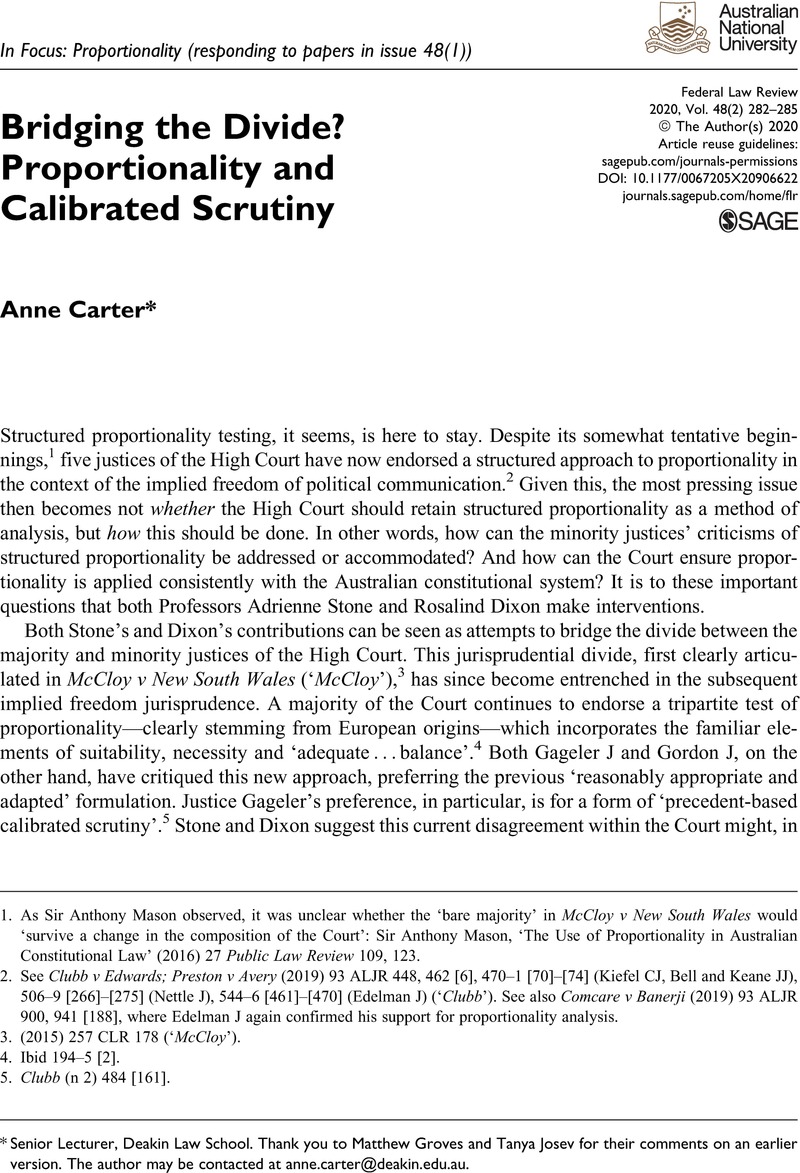Article contents
Bridging the Divide? Proportionality and Calibrated Scrutiny
Published online by Cambridge University Press: 01 January 2025
Abstract

Information
- Type
- Articles
- Information
- Copyright
- Copyright © 2020 The Author(s)
Footnotes
Thank you to Matthew Groves and Tanya Josev for their comments on an earlier version.
References
1. As Sir Anthony Mason observed, it was unclear whether the ‘bare majority’ in McCloy v New South Wales would ‘survive a change in the composition of the Court’: Sir Anthony Mason, ‘The Use of Proportionality in Australian Constitutional Law’ (2016) 27 Public Law Review 109, 123.
2. See Clubb v Edwards; Preston v Avery (2019) 93 ALJR 448, 462 [6], 470–1 [70]–[74] (Kiefel CJ, Bell and Keane JJ), 506–9 [266]–[275] (Nettle J), 544–6 [461]–[470] (Edelman J) (‘Clubb’). See also Comcare v Banerji (2019) 93 ALJR 900, 941 [188], where Edelman J again confirmed his support for proportionality analysis.
3. (2015) 257 CLR 178 (‘McCloy’).
4. Ibid 194–5 [2].
5. Clubb (n 2) 484 [161].
6. Rosalind Dixon, ‘Calibrated Proportionality’ (2020) 48(1) Federal Law Review 92, 121.
7. Adrienne Stone, ‘Proportionality and Its Alternatives’ (2020) 48(1) Federal Law Review 123, 153.
8. Ibid 135, 140.
9. Ibid 148, 152.
10. Dixon (n 6).
11. Anne Carter, ‘Proportionality in Australian Constitutional Law: Towards Transnationalism’ (2016) 76 Heidelberg Journal of International Law 951, 962.
12. See, eg, Julian Rivers, ‘Proportionality and Variable Intensity of Review’ (2006) 65 Cambridge Law Journal 174.
13. Tajjour v New South Wales (2014) 254 CLR 508, 575 [132].
14. Note, however, that the joint judgment emphasised that proportionality provides a ‘uniform analytical framework’ and also noted that ‘no decision of this Court has imported into Australian jurisprudence the scrutiny of compelling government interests applied in United States constitutional jurisprudence’: see McCloy (n 3) 215 [72], [74] (French CJ, Kiefel, Bell and Keane JJ).
15. Brown v Tasmania (2017) 261 CLR 328, 369 [128]. In particular, they suggested that a ‘heavy burden would ordinarily require a significant justification’.
16. In Canada, for instance, the Supreme Court has insisted that s 1 provides a single standard of review: Thomson Newspapers Co v Canada (Attorney General) [1998] 1 SCR 877, 941 [90]–[91] (Bastarache J); Robert J Sharpe and Kent Roach, The Charter of Rights and Freedoms (Irwin Law, 5th ed, 2013) 79. Note, however, that in practice there is considerable variation in the application of this standard.
17. Dixon (n 6) 116–18.
18. Stone (n 7) 152.
19. See, eg, Stone (n 7), 134–42.
20. As explained above, Dixon seeks to do this by identifying context-specific factors and constitutional values that will be relevant to a calibrated approach: see Dixon (n 6) 97–8, 103–13.
21. Dixon is more explicit in this regard, but Stone acknowledges that her argument ‘clears the way’ for the adoption of proportionality: Stone (n 7) 125.
22. Anne Carter, ‘Constitutional Convergence? Some Lessons from Proportionality’ in Mark Elliott, Jason N E Varuhas and Shona Wilson Stark (eds), The Unity of Public Law? Doctrinal, Theoretical and Comparative Perspectives (Hart Publishing, 2018) 373, 379. See also Carter (n 11).
23. See, eg, Sujit Choudhry, ‘Migration as a New Metaphor in Comparative Constitutional Law’ in Sujit Choudhry (ed), The Migration of Constitutional Ideas (Cambridge University Press, 2007) 1, 21–2. Note, however, that Cohen-Eliya and Porat have argued that local doctrines can also be displaced by the generic and universal nature of proportionality: Moshe Cohen-Eliya and Iddo Porat, Proportionality and Constitutional Culture (Cambridge University Press, 2013) 150.
24. Clubb (n 2) 546 [470].
- 1
- Cited by

